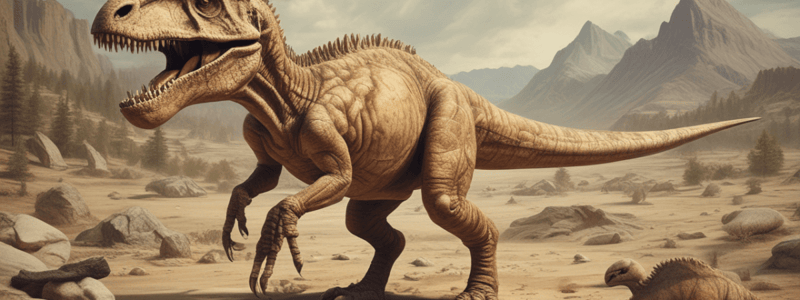Podcast
Questions and Answers
Robert Plot was a Chinese naturalist who discovered a thigh bone in 1677.
Robert Plot was a Chinese naturalist who discovered a thigh bone in 1677.
False (B)
The KT extinction occurred between 64-66 million years ago.
The KT extinction occurred between 64-66 million years ago.
False (B)
The mosasaurs were aquatic flowering plants that went extinct during the KT extinction.
The mosasaurs were aquatic flowering plants that went extinct during the KT extinction.
False (B)
During the KT extinction, almost a quarter of life on Earth disappeared.
During the KT extinction, almost a quarter of life on Earth disappeared.
After the KT extinction, the landscape was dominated by flowering plants.
After the KT extinction, the landscape was dominated by flowering plants.
Flashcards are hidden until you start studying
Study Notes
Discovery of Giant Bones
- In 1677, Robert Plot, an English naturalist, discovered a thigh bone belonging to an animal that was one and a half times his height.
- He initially thought the bone belonged to a giant.
Dinosaurs and Their Extinction
- Dinosaurs, such as iguanodons, microraptors, and tyrannosaurs, dominated the Earth's landscapes, but they disappeared completely between 66-64 million years ago.
- This event, known as the KT extinction, marked the transition between the Cretaceous and Tertiary periods of geological history.
Consequences of the KT Extinction
- During this catastrophic period, almost three-quarters of life on Earth became extinct.
- Many species disappeared, including:
- Ammonites and belemnites from the oceans
- Nanoplankton species
- Two entire groups of clams
- Relatives of modern starfish, sea urchins, brittle stars, and sea cucumbers
- Mosasaurs, the ocean's top predators
- Winged pterosaurs
- Flowering plants, leaving behind a landscape dominated by ferns.
Studying That Suits You
Use AI to generate personalized quizzes and flashcards to suit your learning preferences.




